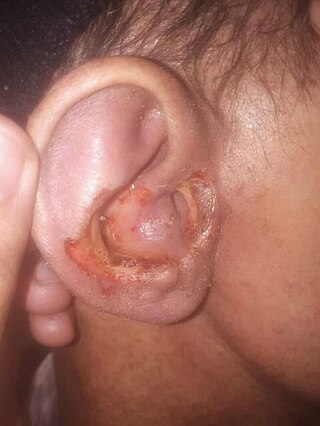Top Qs
Timeline
Chat
Perspective
Trigeminal trophic syndrome
Medical condition From Wikipedia, the free encyclopedia
Remove ads
Trigeminal trophic syndrome is a rare disease caused by the interruption of peripheral or central sensory pathways of the trigeminal nerve. A slowly enlarging, uninflamed ulcer can occur in the area that has had trigeminal nerve damage; including but not limited to the cheek beside the ala nasi.[1]: 65
Remove ads
Signs and symptoms
The most common complaints are feelings of picking, rubbing, or scratching in the afflicted areas. A nonhealing ulcer is present in most patients. The ala nasi is frequently affected by a recognizable, painless, sickle-shaped lesion with a well-defined margin. The ulcers are incredibly persistent once they start.[2]
Causes
Trigeminal trophic syndrome can present with the following conditions and diseases: syphilis, amyloid deposits in the CNS and trigeminal nerve, trauma, craniotomy, tumor, Wallenberg syndrome (stroke/vascular insufficiency), herpes zoster, herpes simplex, syphilis, and neurological complications from birth trauma or it can be idiopathic.[3]
Treatment
Treating trigeminal trophic syndrome is a difficult task. Among the options are transcutaneous nerve stimulation, protective dressings, behavioral modification, medication intervention, and surgical repair; however, none of these have been proven to be consistently effective.[3]
Epidemiology
Sixty cases were reported from 1982 to 2002.[4] Trigeminal trophic syndrome is more common in women as compared to men.[5]
See also
References
Further reading
External links
Wikiwand - on
Seamless Wikipedia browsing. On steroids.
Remove ads

